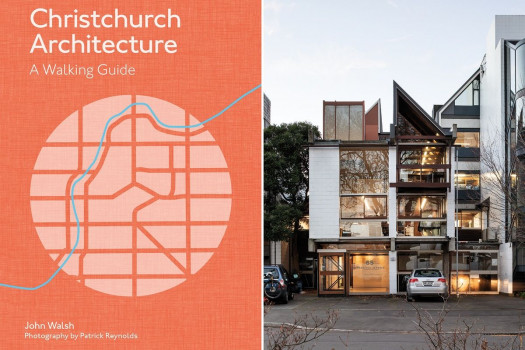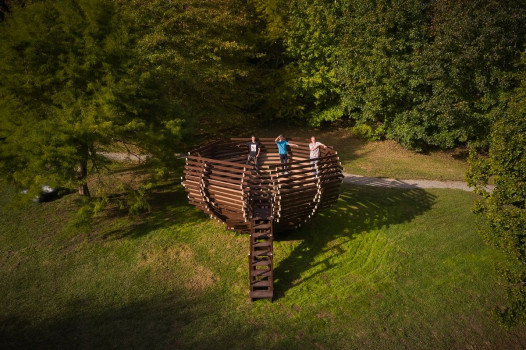Not a Dress Rehearsal




You arrive completely ‘unborn’, in a state of ignorance. You don’t even know you don’t know but you arrive at university, the School of Architecture, and your next life begins. You slowly learn to become an architect. You grow up, have a few wild moments of self-belief and knowing, surety, clarity of purpose. Then it’s back to the doubt. All the while, the passion for what architecture might be propels you on.
Working in a sea of doubt. Architects choose what must be the cruellest profession: one that requires you to make enormously manifest, larger than life, something that starts as a kernel of an idea inside your head. Something permanent, waterproof, functional, beautiful. What isn’t there to worry about? To perform this dazzling act of radical uncertainty requires assembling at least a band of helpers, usually a symphony orchestra of consultants and, occasionally, a massed choir of supporters. Fabulous really.
Who sets you off on this journey? Teachers – wonderful teachers. The School of Architecture in the late 1970s was an extraordinary place to be. Mark Wigley, in his 2021 Fast Forward lecture, described it as a large playhouse, like a nest: a place of experiments and experiences, physically and socially. His strongest memory was of how kind and open the people were, teachers and students often indistinguishable through the hair. He is right. For me, I met my new family or whānau, as I happily say today. Friends, lifelong friends and colleagues. Architecture also gave me ancestors, a lineage, and an eye to the future.
The humanist tradition was strong. Professor Dick Toy would gently describe the landscape of ridges, valleys, volcanoes and harbours of Tāmaki Makaurau in terms of settlement. I see now his lineage to Lloyd Rees and Richard Leplastrier in Sydney, though I’m not sure they ever connected.
John Goldwater was my first studio teacher, another gentle man, who would talk about how to set the scene for the big acts of habitation – the coming together for the rituals of life, eating and sleeping, and the art of placing a window and opening a door. There was talk about his concrete-block house in Grafton Gully being a masterpiece destroyed for the Grafton motorway.
Then there was the wild, cinematic exuberance and imagination of John Dickson, who could take you around the planet without ever leaving Milford. A genius teacher sadly unrecorded. But his limitless quadrant of spatial terms organised on an axis (e.g. open/closed, inside/outside) gave us a framework in which to analyse the physical and emotional world we were discovering. It was a framework filled with passion and imagination, if we opened our eyes.
And, of course, David Mitchell: the man who influenced so many of us, but especially me. It was David who really made architecture an enrichening experience for me. It formed the framework of our lives together.
David – instinctive, intelligent, deprecating, funny, poetic, practical, orientated always to the humane and with a fine eye for detailing. Architecture was his art. Coming from a line of teachers, he was a natural teacher himself.
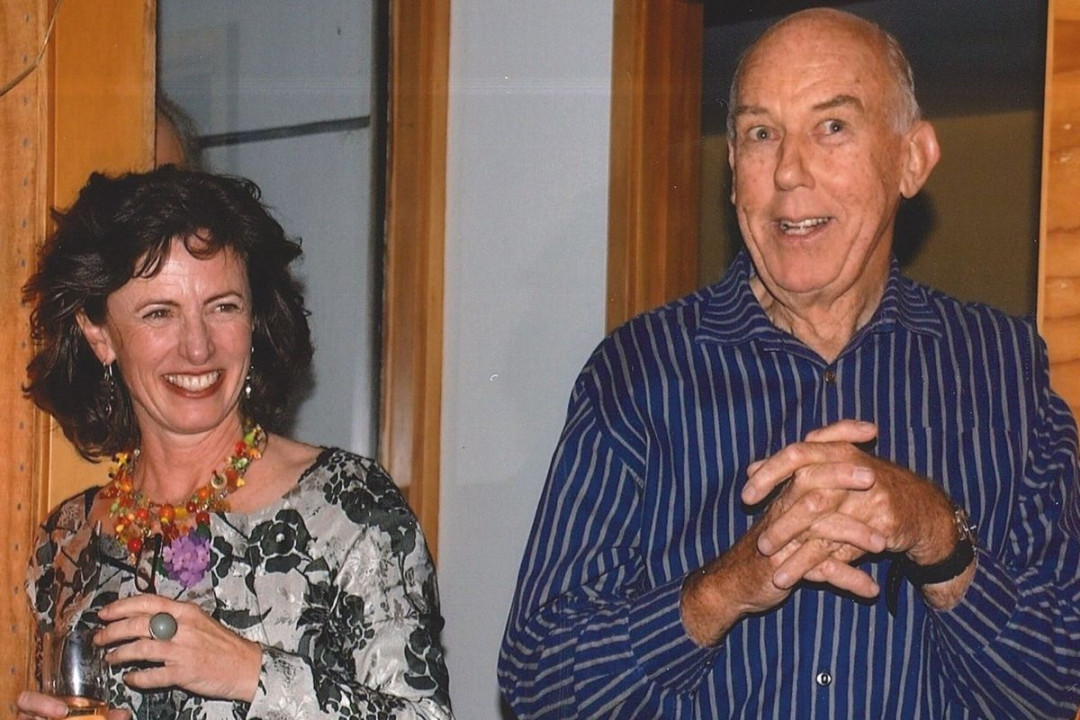
David Mitchell speaking at Julie’s 50th birthday party, 2008. Image: Supplied
Designing and David
Our orbits gradually fell into synch until we became our own little system – constantly, happily, in each other’s gravitational pull. We were very alike, had the same way of seeing the world and, most of all I think, a similar sense of humour. Despite our age difference of 17 years and David’s already strong mana in the architectural world and my general lack of anything, from the beginning it was always a relationship as equals: everything shared. We never married because I didn’t want to be known as “David’s wife” and, besides, any money was best spent on a house or boat. And then it didn’t matter. We were together. Designing together. Heke Street (our own house after a few years together) was our first test and set the working relationship. Lots of quiet thinking/drawing time, till coffee or ‘wine o’clock’ allowed a long discussion; then repeat. (With Heke Street, that went on for a over a year.) Often, one would say, “I want to run with that idea” and go away and work on it, while the other did something useful like the washing or sailed the boat to another bay.
Later, others would be involved – Julian (Mitchell) especially – and crits would be lively events in the office. Nothing was done alone and it was always focused on honing the idea.
What a delight David was to work with. His ability to come up with something completely left-field was always surprising and then he would beaver away for hours detailing it. He’d probably say the same about me – but not the second part.
Vision
It was Pat Hanly and Claudia Pond-Eyley in Drawing (years one and two) who would urge us to capture the essence of something in five minutes flat: Pat squinting as the words “Get the Big Idea” squeezed out of his clenched mouth. It continues now with Pip Cheshire demanding “Where’s the ideogram? Six lines – that’s all!”
It is a skill that not all architects have, just as not all of us can make the slightest sense of, say, MasterSpec. We all have different receptors in our brains but being able to formulate and articulate a vision is a skill that architects recognise. It is this skill of understanding and visualising the 3D world of the built environment, as well as the social and the environmental landscape, that I believe is being marginalised in our city’s planning, as layers of urban planners and landscape architects fill the graphic gap.
This lack of understanding of having a vision, or not valuing a design-led approach to our city at the highest political level of our council, has been most noticeable in the bureaucratic dismissal of the Auckland Design Office in 2020, at a time when Auckland is experiencing the fastest and greatest urbanisation of its existence.
Meanwhile, in teaching MArch studio, I love exploring these ‘Big Ideas’ with students. For example:
• Queens Wharf being reconfigured as a new urban landscape for Ngāti Whātua Ōrākei to create an urban marae atea right on our waterfront where our city meets the Waitematā: a space for welcoming people, showcasing people’s cultural histories and holding festivals
• Devonport Village as an historic seaside village, urbanised to take 2000 people while keeping its heritage
• An Urban Room for Aotea Square – a forum in which to discuss the city’s development
• A new Framework Plan for Manukau City Centre to make Manukau a great place for 10,000 people to live in: the first South Pacific city that reflects their culture.
Who wouldn’t be excited about all that?
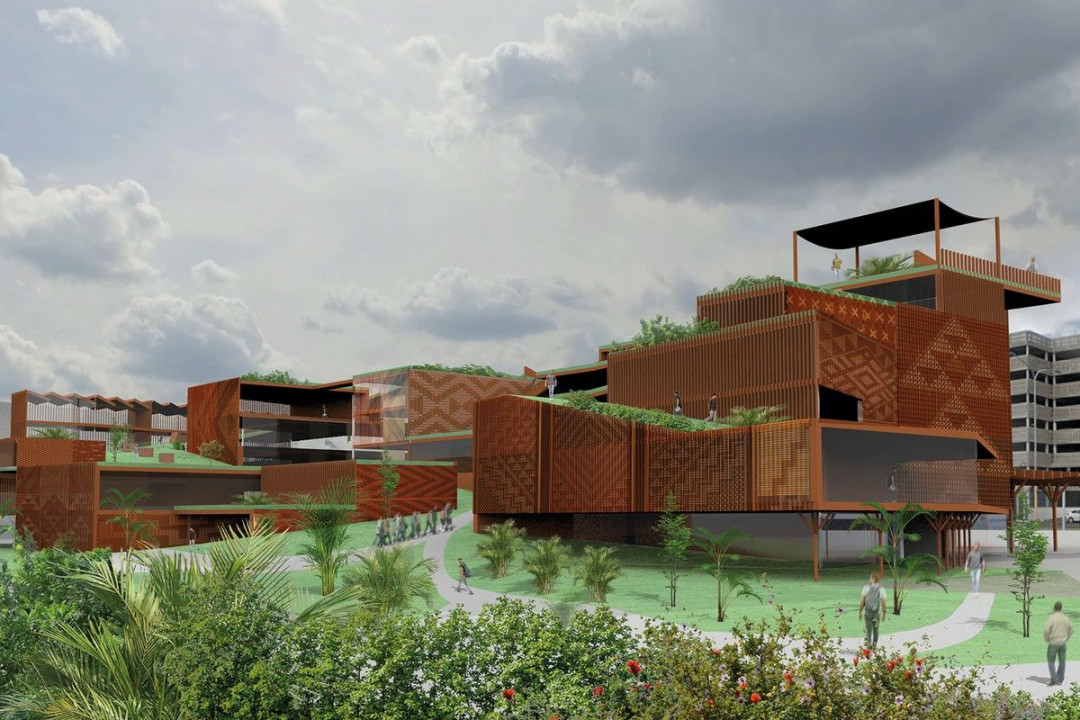
Making a new maunga for Manukau City, incorporating commercial, social and housing; 2021 Architectural Design 2 project by Sam Jones. Image: Supplied
Cultural diversity poses interesting architectural tasks for our future city. Through my students and my studies, I learn about different cultures’ perceptions of space. Māori, Oceanic, Japanese, Chinese, Asian, Arabian: all of these shift the axis of my world.
Discovering that space is actually a physical entity, palpable, a connector and not an emptiness or void, was a jolt to my brain. Understanding the nature of the spiritual life of ‘things’, such as the Whanganui River as a living being, was a jolt to my heart. Spaces and places started to make a connected sense on many levels. I knew it all intuitively, except I didn’t ‘know’ it.
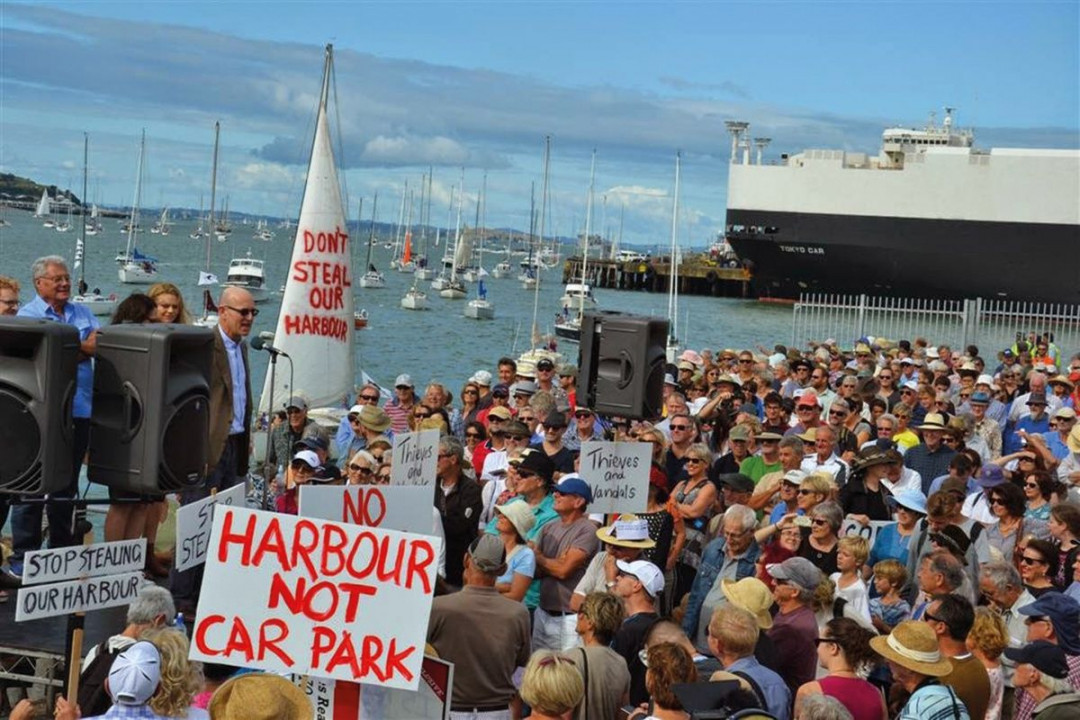
Stop Stealing Our Harbour protest on land and sea, 2015. Image: Supplied
Activism
On my return to Auckland in 2000, my interest in the city and how it could be was growing – a reaction to the awfulness of the central city and the lack of love being shown to it.
For years, I had carried a postage stamp in my wallet of Colin McCahon’s Northland Panels – a landscape with too few lovers. Coming from the windswept plains of the Manawatū, this resonated with me but, here, its sentiment was manifest in our city, our harbour, my home. Something had to be done.
Amanda Reynolds, a good friend, stirred my interest in urban planning. She, Malcolm Walker and Don McRae had earlier managed to head off the catastrophe that the Les Mills’ Britomart development would have been.
It is difficult to be succinct on something that has enveloped my life for 20 years: NZIA Urban Issues Group, The Mayoral Forum on Urban Design in 2005, The Auckland Plan, Urban Auckland leading to the High Court Ports of Auckland (PoAL) battle in 2015, Stop Stealing Our Harbour and, later, taking Environment Court action to stop the mooring dolphins off Queens Wharf. The important thing is to do something, actually: to speak up. It is easier when there is a group of you, even if just a few, as in Urban Auckland. Collective action is important. It will find collective goodwill and gain momentum and become powerful. But it needs to be productive and focused on a goal. It involves a lot of talking, lobbying, meetings and engaging with people from different backgrounds. Often, for me, talking with people has been driven by being unsure about whether or not I have the picture right and wanting to hear what others might think is the way forward.
I have been really impressed by the power of bringing people around the table to discuss something in which they all have a shared interest. In 2005, Graeme Scott and I lobbied for the Mayoral Task Force on Urban Design, which brought together property developers, council officers, architects, landscape architects and community groups to formulate a ‘springboard’ for how this city might develop as a design-led city.
Urban Auckland’s 2015 win in the High Court gave us the leverage to insist that Auckland Council undertake a Port Future Study that took in not just economic factors, as before, but environmental, social and cultural factors. It seems crazy that we had to fight for that then but it is even more crazy that we still do as the long-term battle plays out.
What was really impressive about the Port Future Study was the bringing together of 16 ‘stakeholder’ representatives from around the spectrum of interests: Ports of Auckland, shipping companies, business, supply chain, iwi, economics, environmental and community. I represented the built environment. Each group had to present its case for how it saw the issue of the port in relation to the city and the harbour and what mattered. We all agreed on the importance of the Waitematā – it was the following ‘but’ that we were there to discuss. At first, sides were drawn but we were able to engage as people, to laugh and joke as we argued. We brought in experts and sent out for hard facts. Slowly, over months, the ground around the table shifted. In taking a longer, informed view, perspectives change. It was a general surprise to all that we did finally reach a consensus – the Port is outgrowing its location and its welcome (or social licence to operate) and will have to relocate operations by 2040, if not sooner, in the case of the car imports.
The same thing happened with Panuku’s proposal to put concrete dolphins off Queens Wharf in 2018 to berth the super-sized cruise ships. Urban Auckland led legal proceedings in the Environment Court to force a mediation between parties rather than the stand-off between lawyers. I knew neither Ngāti Whātua Ōrākei nor the cruise industry wanted the dolphins. We all wanted a well-planned, long-term solution that involved Bledisloe Wharf as more than a car park. In a personal meeting with the Mayor, I presented our case and he agreed to a delay while we all could meet in mediation and talk with PoAL for a solution. The Resource Consent for the dolphins was eventually rescinded but long-term talks on the waterfront and PoAL’s future have been stalled with Covid. The need to have them, however, is more pressing than ever.
Another moment of quiet pleasure has been watching the tanks being removed from Wynyard Wharf and seeing longer-term plans for that area’s revitalisation being undertaken as a legacy from the America’s Cup campaign. Again, it seems so obvious now, but it was a bloody battle with Panuku and its advisors to prevent the building of a 220-metre wharf out into the harbour and blocking views from the Viaduct Basin. Determined collective action by Urban Auckland, Stop Stealing Our Harbour and Viaduct Harbour Holdings, and, finally, a great effort by the Minister for the Environment, David Parker, finally resolved it.
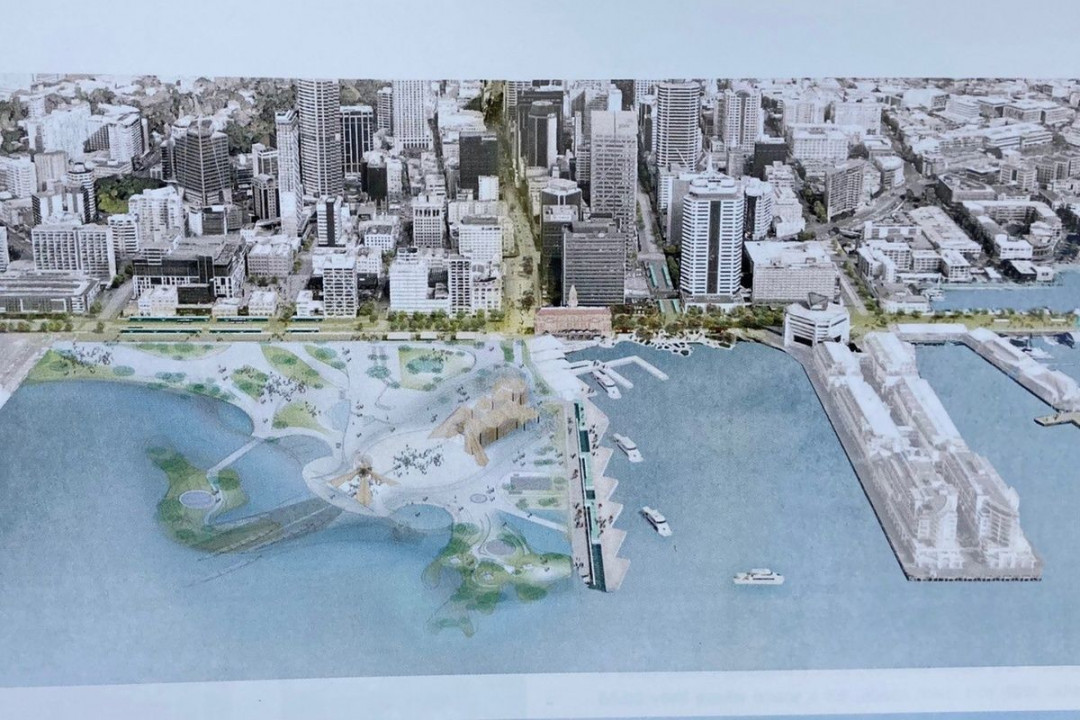
New Urban Landscape for Queens Wharf; 2020 Architectural Design 1 project by Emma Stewart. Image: Supplied
There is still a lot to do to carry out the vision of the Auckland Plan, to make this place a vibrant, diverse and unique urban environment for all. Terrific things are happening all over. Many talented people now work in the field of urban design. We are a super city. But I do believe our profession should be more politically active, with a City and Government Architect/Urban Designer leading the visioning for the urban environment, working right at the top of the decision-making chain.
Being a woman in architecture
I have been blessed in life in that, at every stage, I have been nurtured, loved, supported and free-educated, and I have had the freedom to do, virtually, whatever I wanted to do. I want to acknowledge all those great people who have been there for me. I have done none of this on my own.
I would like to think that this is normal but I’m not naïve. Why any society or group would not ensure it garnered the collective abilities and strengths of its members, both male and female, is a mystery to me. Again, this is something that Māori culture can teach us.
Early on, my anxious, newly widowed mother was warned by an acquaintance that “Julie will never make it in architecture as she doesn’t have connections”. What I eventually found was my whānau and a network of colleagues who have been a great strength. We owe it to all to maintain those networks of collegial support and I acknowledge the Institute’s work in this area. Connections may still ease the path of some architects but I can attest it’s not everything.
I also found male architects and builders who took time to explain to someone who palpably didn’t have a clue at first and, later, that working together as a team on a project is one of the great joys of the job.
I take my hat off to the work started by Lynda Simmons and others in forming Architecture+Women•NZ, which is actively working out ways to assist women to succeed in the profession. It is an inspiration of support for many. The recognition from my fellow women colleagues in being awarded the first A+W Chrystall Excellence in Architecture Award in 2014 was a great honour. Since then, a growing number of talented women have been recognised and celebrated by A+W so the path is set. I would like to think that these awards reflect well back on others and encourage more to belong to the profession. It is vital for all of us to facilitate a healthy, diverse and sustainable workplace, where both women and men are supported in their career paths in league with family-raising. It’s the village we belong to.
The ‘unborn’ ignorant me of 45 years ago would be staggered to see where she got to. It has been teamwork. But she certainly wouldn’t even have stopped to think about it. That’s what life is. It’s not a dress rehearsal. You just get on with the present, working out your own course with the currents, eddies, tides and opportunities that come your way. Luck has a huge part in it but so, too, does tenacity. Never underestimate tenacity, determination and sheer grit. A girl’s got to have it.
But there are serious issues confronting us that require our attention. So, to the young coming behind me I say: remember you have a voice – a voice to speak out against things you don’t agree with. Also, you have a voice to talk to people you don’t necessarily agree with. You can have a conversation and, chances are, you will make a friend. It is important to speak out – be it about your education, your neighbourhood or your city. We are all part of this wonderful human construct called a society, a city. Let’s make it the most joyous, inclusive and fabulously designed place we possibly can.
The education of an architect
Today, university education can feel like an industry run by managers with little connection to those of us who actually work directly with the students. The University of Auckland School of Architecture and Planning has taken some hits, in particular the removal of our specialist library now merged into the main campus library. Ironically, just when so much of our architecture teaching is about embracing Oldenburg’s concept of ‘third space’ and the great benefits of social collective spaces within communities, we have lost our own heart. While the books are generally still available in the main library, fourth floor down the back, it is in no way the same as having your taonga right there in the heart of your school: a repository of so many ideas and images. It was a place to hang out between lessons, to graze the shelves. The best thing was the randomness of the selection off the returns trolley, something you had never seen before, or the new arrivals shelf: always a source of something really interesting. You may say it is all online but it isn’t. The library provides a different way of learning: deeper and more connected to us as an architectural community. And that is the other loss I feel. The sense of connection to the architecture community that many ex-students had with the place. They would come back to browse, be part of the school. And they would feel part of the community to which they would eventually give back, be it archives or scholarships. A tradition was broken.
Another intrinsic part of architectural education that I believe is under threat by university higher management is the teaching of studio. Over the last 10 years, studio time for MArch students has been cut from 16 hours a week to 12, eight and, now, six is being proposed. With student class numbers of 18 per tutor, that means 20 minutes ‘quality’ teaching time each a week. Yeah, right.
Studio is the heart of architectural teaching. It is the synthesis of all the other courses. It teaches us how to work in groups, how, actually, to learn our biggest skills as professionals – problem-solving, untangling all the issues and formulating a design idea. The articulation of all that through drawing is one of the greatest creative outpourings of studio. None of this happens without quality time spent by tutors contributing to each student’s development, guiding each of them to discover how to see for themselves.
Wonderful teachers open our minds to ways of seeing. Mark Wigley described the School of Architecture as a “warm and kind place”. That is certainly my memory of it and I would like to think it is the same today. The members of staff today are certainly amazing, talented, diverse, warm-hearted people with whom I find it a joy to work, but the restrictions of Covid and online teaching have taken a toll on all of us. It is the collegiality we miss. I hope we get it back soon.
Julie Stout is a partner at Mitchell Stout Dodd Architects, a professional teaching fellow in the Masters Programme at the School of Architecture and Planning and past-chair of Urban Auckland.
This article was first published on architecturenow.




 Indonesia
Indonesia
 Australia
Australia
 Philippines
Philippines
 Hongkong
Hongkong
 Singapore
Singapore
 Malaysia
Malaysia


